Marine Corps Vietnam War Naperville, IL Flight date: 07/20/22
By David Adams, Honor Flight Chicago Veteran Interview Volunteer
Christopher (Chris) A. Mead was born in 1944 in New York, NY, the oldest of six children. He was raised in Stamford, CT. graduating from Stamford High School in 1962. Chris persisted in his efforts to attend the University of Notre Dame which eventually accepted him into the class of 1966. Not unlike most male students in the mid-60s, Chris weighed his military options. He originally signed up for the Army ROTC but wisely, he admits, “I subsequently dropped the program to concentrate on studies.” In his junior year, he remembers, “Vietnam was heating up (Tonkin Gulf incident, Marines landing in Chu Lai, etc.); I needed to make a post-college choice. I was exhausted with academia. Why not go for some change and excitement in life?” Discussing non-Army options with the Marine recruiter, he signed up for Officer Platoon Leaders Class (PLC) which started in the summer after his junior year.
He was following in the footsteps of a family dedicated to military service: his great grandfather, an Army Colonel, WWI and WWII; his father, a Navy Rear Admiral, Navy WWII, Korea, and Vietnam; and an uncle, an Army Air Corps and USAF Colonel, WWII and Korea. One of his brothers served in the Navy and a cousin in the Army, both in Vietnam.
As a college student, he attended the first six weeks of the PLC program at Quantico in early summer 1965. Chris recalls being “greeted” by a Marine sergeant, escorted to a green cattle-car bus and entered with a dozen or so others headed to Boot Camp. The no-nonsense sergeant stepped in, closed the bus door, and in a barking tone introduced himself as our new and ONLY “Mother” for the foreseeable future. Only two speaking rules for responding: “Sir!” and “Yes Sir or No Sir”.” In June 1966, he graduated from Notre Dame with a Bachelor of Business Administration degree with a major in Accounting and minor in Management. Following graduation, he returned to Quantico to complete the second phase of six week PLC training and then be commissioned a 2nd Lieutenant.
The Basic School (TBS) for new officers at Quantico “was a 21 week blur” according to Chris. He remembers qualifying as a pistol expert and rifle sharpshooter. Among the skills he learned were leadership training, weapons and tactics, obstacle courses, combat engineering training with C-4 and shaped charges, land-mine exercises, and nighttime orienteering around and through dense brush obstacles, live fire exercises, combat first aid, and offensive and defensive operations and tactics. Upon completion, Chris got assigned to MOS (military occupational specialty) Air Offense/Defense Control Officer.
His air control training found him at MAD (Marine Air Detachment), NATTC (Naval Air Tactical Training Center), Glynco, GA for six weeks of Air Intercept Control School. He learned air defensive engagement tactics and the characteristics and maneuvering capabilities of all Navy and Marine attack aircraft. The job required use of a large ground-based radar. Advanced training occurred at the Weapons Control Courses for another five weeks at Twentynine Palms, CA. When he returned to his permanent base, Camp Pendleton CA, he considered himself fortunate to attend a program at Marine Corps Air Station El Toro, CA to qualify for a “backseat license” to fly in the F-4 Phantom. He regrets that he did not have a chance to exercise his “license” in Vietnam.
By early January 1968, Chris shipped out to Vietnam joining MACS-4 (Marine Air Control Squadron) located on a peninsula northeast of Da Nang on top of “Monkey Mountain.” The base was located on the peak of Sơn Trà Mountain, overlooking Da Nang Harbor and China Beach. Shortly after he arrived in Vietnam, the infamous Tet Offensive broke out. His unit’s job was to monitor the skies for potential enemy air attacks from the north and west. After about a month on Monkey Mountain in early February, he was transferred to MASS-3 (Marine Air Support Squadron) on Da Nang’s western side. MASS-3 was a sister unit but focused totally on offensive close air support firepower operations for hostile engaged infantry. Chris states that “We were heavily focused on getting air assets out to the FAC’s (Forward Air Controller) embedded within the infantry for close-air support strafing/bombing runs. We worked closely with the Artillery HQ unit bunkered next to us to work out pathways for gunships and emergency medevac helicopters to navigate beneath and around continuous artillery fire trajectories from base to the engaged troops hotspots.”
With more air control experience under his belt, he was airlifted into the besieged Khe Sanh combat base close to the DMZ with North Vietnam while the base was under constant attack. There he continued the above-described work around the area and perimeters. He describes living within a 12ft deep bunker. “Showers for us meant carrying a 5 gallon water can to the 50 gallon reservoir drum topside of the bunker to have water flow down thru a garden hose to a below-ground tiny shower stall. When water was scarce, we pumped out the used shower water that fell through another grate covered drum buried into the bunker floor to repump/take up topside for another reuse. Sometimes you do what you must do to get some amount of that red/brown dirt off your skin or clothes.”
In late April after the siege was lifted, his unit evacuated Khe Sanh to Landing Zone Stud which was within several miles from the DMZ, but west of Camp Carroll, a Marine artillery base. Upon the unit’s arrival Chris says “We set up our tents, dug our own foxholes to jump/roll into, joined tracked vehicle/tank troops in bathing down in a nearby river stream, and later took several rockets in a night or two. We left the LZ within a week and returned to Da Nang.”
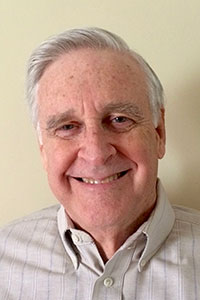
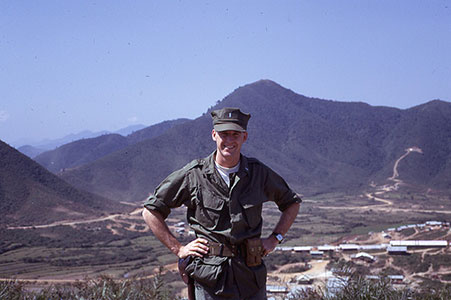
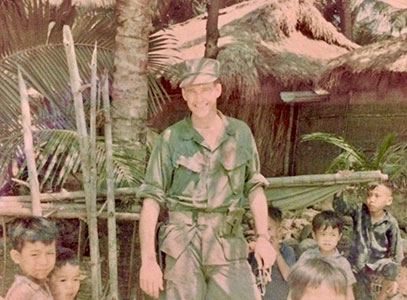
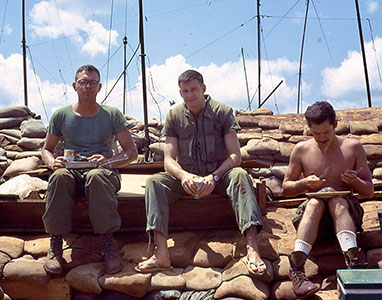
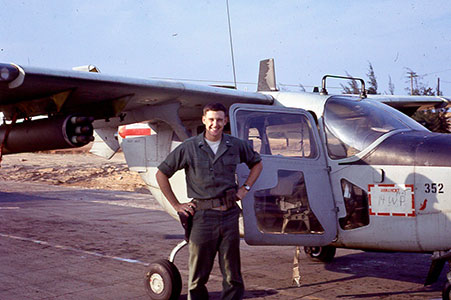
In Da Nang Chris was assigned into the 1st MAW MACG (Marine Air Control Group) compound which had subordinated to his former MACS and MASS reporting units. The MACG received air requests from the field commanders and had direct lines to the airfield squadron’s on-duty pilot’s ready room awaiting mission assignments for scrambling to target areas and FAC’s. His responsibilities included assigning mission numbers to scramble fighters and bombers, getting refuelers aloft, preparing flareships for night work, and helos for medevacs, to provide quick troop support in uncertain times.
Soon a new air control agency was formed to help alleviate the risks of multiple aircraft engaging in similar tasks. It was called I-DASC (I-Corps Direct Air Support Center) and composed of both Air Force and Marine Air Liaisons. Because of his wide variety of in-country USMC air control facilities experience, Chris was assigned as the Marines Air Liaison for a few weeks during the summer. He remembers vividly, “Among one of my I-DASC experiences was to be a ‘right-seat’ accompanying an Air Force Major piloting a front and rear engine Cessna O-2 spotter on missions to reconnoiter an area west and southwest of Da Nang along the Laos/South Vietnam border for targets along the ‘Yellow Brick Road’, aka the Ho Chi Minh Trail. We typically flew between 2-4000 ft above ground to minimize small arms fire. After finding a target of opportunity we dived and marked the target area with a colored smoke rocket shot from a pod under each of our wings. After the fighters attacked the target, we reported with a BDA (bomb damage assessment) to flight lead.”
While based in Da Nang, Chris periodically accompanied several medical assistance visits/patrols to certain remote outlying villages as part of efforts. In his words, “To ‘win over the minds and hearts’ of villagers through much needed medical care to both adults and children. Of course, we still needed to keep alert for risks, unusual behavior, and stay attentive for any helpful intel.”
When his thirteen-month tour in Vietnam was over, Chris boarded a PanAm flight headed home in January, 1969. He recalls, “The flight stopped in Okinawa for two rest days to be inspected for any live ammo or arms, then on to San Francisco, and Camp Pendleton with further leave to home in Connecticut.” He remarks that “Within days, I was married on February 1, 1969 to my sweetheart of five years, Janice Gilmartin, and then we honeymooned our way by car back to duty station at MACS-7 in Camp Pendleton CA.” Chris was honorably discharged from active duty effective July 15, 1969 as a 1stLieutenant. Following his discharge, he transferred to the Reserves and ultimately attained the rank of Captain, USMCR. For his Vietnam service, he was awarded the Combat Action Ribbon, National Defense Service Medal, Vietnam Service Medal w/3 bronze stars, Republic of Vietnam MUC Gallantry Cross & Medal, and Republic of Vietnam Campaign Medal w/device.
Back to the academics he left behind in 1966, Chris enrolled in the MBA program at the University of Chicago, he says, “to sharpen my business skills, majoring in Finance, with a second major in International Business.” More importantly, he recounts the following: “Some anti-war students were peacefully blocking our building entrance on the first day of class. I had no sympathy for that crap, so with some frustration I quickly grabbed two of them and threw them off the steps, somewhat stunned. A news reporter was there and asked me a question. I briefly told them I was here to attend the school at my expense, and I did not intend to put up with any draft evading “hippies” and war protesters blocking my path or rights to attend. Unbeknownst, that short encounter was part of the local Chicago newscast that evening. In later reflection, I was proud to have taken that stand.”
Following graduation, Chris joined Ernst & Ernst CPA in June 1971. He later worked for Tiger International (of the Flying Tigers legacy) and the Bosler Supply Group in Chicago. In 1986, he joined Schawk Inc, a small privately held company headquartered in Des Plaines. Over the next 28 years he rose to VP-Corporate Development. Chris says that his retirement in 2014 “allows more time for visits with my two handsome sons and five grandchildren, my two sisters and to the related family relations of my loving and devoted spouse, Janice. We have embarked upon several leisure travel trips abroad and hope to do more future trips, both domestic and international.”
Chris confesses, “Vietnam is not on my bucket list to return. I can still recall sitting on top of my Khe Sanh bunker with buddies remarking how much like a garbage dump the base looked. Peering out over the post-battle landscape we compared the craters and hillside scars all around to features on the moon. Then we all joked that someday crazy tourists (but not us) of another generation may be here to sightsee the DMZ area or this God-forsaken Khe Sanh wasteland, or even build a golf course upon it!”
What did Chris learn in the Marines? Answer: How to grow up FAST among rapid challenges around you at just about any time. Essentially, learning to be quick on the ‘uptake’ mentally in assessing new and unforeseen situations, and developing an actionable plan therefrom. He is forever grateful to the USMC global brotherhood and its enduring Esprit de Corps. “Once a Marine, Always a Marine.” OO-RAH !!
Thank you, Chris, for your dedication and distinguished service during challenging times. Enjoy your special day of honor in Washington D.C. with your comrades in arms! This will surely be a splendid welcome home.


